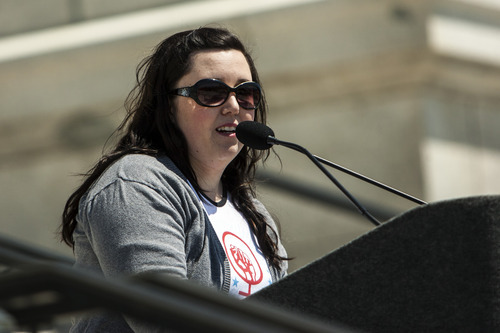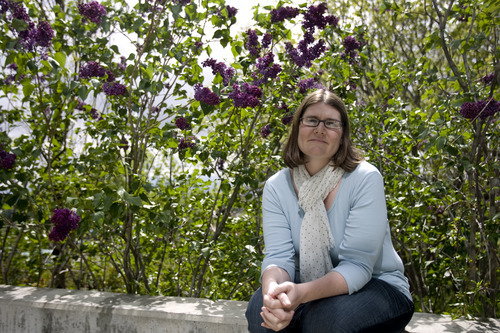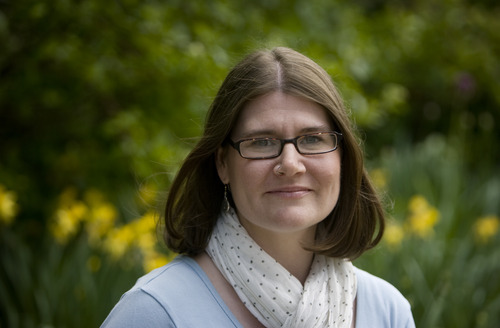This is an archived article that was published on sltrib.com in 2012, and information in the article may be outdated. It is provided only for personal research purposes and may not be reprinted.
A few years ago, Amy Jensen had more employment and educational experience than most Utah women her age. She had worked for years in victim advocacy and law enforcement, while raising a daughter on her own, but opportunities for advancement and better pay had dried up because she didn't have a college degree.
Jensen, 45, started at the University of Utah two decades ago, with her sights set on becoming a photojournalist. Later she got interested in psychology, then police work, but dropped out as the demands of parenting and work became too much to balance with college. But she didn't give up on higher education.
Jensen's 21-year journey reaches the finish line Friday when she joins 4,855 other U. undergraduates getting bachelor's degrees.
Her story exemplifies an issue that seems unique to Utah and doesn't bode well for the state's economic prospects. Facing a range of cultural hurdles, Utah women have not entered or completed college at the same rate as men for years. Just 26 percent of Utah women held a bachelor's degree in 2008, versus 32 percent for men, according to a 2009 Utah Foundation study.
While women are a 55 percent majority of undergraduates nationally, in Utah they are closer to a 45 percent minority. The gender gap in higher education has caught the attention of administrators and policymakers who want to learn why and how to get more women through college. Finding solutions is critical if the state hopes to reach its goal of increasing the share of the working population with a post-secondary credential to 66 percent, officials say.
The Legislature earmarked $100,000 to implement recommendations recently released by the Utah Women's College Task Force, which Gov. Gary Herbert convened last year.
Research conducted by Susan Madsen, a Utah Valley University management professor, provided the task force with key findings. Her team performed in-depth interviews with 245 young Utah women, mostly white and Mormon.
"One key piece was aspiration. If you don't aspire to graduate, you aren't going to. They didn't think [college] was about graduating," Madsen said.
—
On their own • In today's recessionary times, older women are returning to Utah campuses in ever larger numbers. And many, such as Weber State University's Amy Kunzler, have small children but no husband.
Kunzler resumed college after her divorce so she would be able to support her three kids, ages 7, 9 and 10.
"It has been a challenge with late nights and everything else. Homework doesn't get done until after bedtime," Kunzler said. She graduated this month with a bachelor's in education and hopes to be teaching in Davis County schools soon.
"Single moms have to stay home if their kids are sick or the baby sitter bails. We have a big shortage of care on campus. We have a lot of options, but they're full," said U. student Victoria Billings, the nontraditional student outreach coordinator for the school's student association.
A university education was Billings' 30th birthday present to herself in 2007. To her lasting regret, she bombed out of college in Alaska her freshman year right after high school.
"I could be so much farther along, but I didn't know what I wanted to do then," said Billings, who is divorced with no kids. She was working a dead-end job in a Utah County call center when she decided to pursue a degree in environmental studies.
Nearly 20 years younger than Amy Jensen, Sara Librandi is following a similar arc. Now 26, she started college at Weber State University right out of high school, but the 2004 Alta grad didn't like Ogden much. Librandi dropped out in her second semester, returned to Salt Lake City, found a job, got married, had a baby.
She returned to school at Salt Lake Community College as a single mother but lasted only a semester.
"Once you get out, it's hard to get back in," said Librandi, whose son starts kindergarten this fall. "Trying to work around a small child, working full time, finding the time for [college] is difficult. We would have to take out a ton of loans."
She now runs a real estate management company and is active in women's rights. She hopes to eventually earn a bachelor's degree in political science.
"I would never want to be a politician, but being involved in politics would be a good fit because I'm very passionate," Librandi said. Her own mom graduated from the U. three years ago with a bachelor's degree in accounting at age 50 and now works as a CPA.
Billings contends older students have the maturity and focus to be successful in college, but universities need to have programs to help them juggle the multiple obligations in their lives.
"We don't have the option of taking a couple years off and figuring out who we are. We have to know that already," said Billings, who praised initiatives taken by U. administrators to help nontraditional students, particularly veterans.
Billings graduates Friday and starts next fall in the University of Oregon's nonprofit management graduate program. She hopes to be executive director for a conservation group within a few years.
—
Cultural factors • Early marriage is a commonly cited reason for Utah women dropping out of college in high numbers. Utahns, on average, marry young, and when babies arrive, the woman is often the one to abandon school to manage the domestic front and support the family.
But this sheds little light on why fewer Utah women than men enter universities out of high school. Madsen is stumped on that question, but a recent survey suggests many Utahns don't believe a college education is as important for women.
Some observers argue that women go to college as a path to marriage, rather than a degree.
Jensen said learning was valued in her childhood home in Draper, but college was never talked about. That was for people with money and privilege. "We believed graduation from high school gets you a fair-paying job. I would get married. My life would circle around my husband. It didn't work out that way," Jensen said. "I was ill-prepared, to say the least, for my future."
When she started at the U. in 1991 as a 23-year-old single mother, she didn't know how to declare and pursue her major and secure aid, nor how to get the answers.
"I had no idea there were scholarships for single mothers," Jensen said. "I didn't hang out on campus. I didn't know where the [student] union was. I went to class and left."
Off campus, she worked various jobs and pursued peace-officer training at Salt Lake Community College. Salt Lake City police recruited her to establish a domestic-violence victim advocacy program, supervising volunteers. Her police work expanded to include evenings as a decoy prostitute for the vice squad. As student loans mounted, she pulled out of college in 1995. A dozen years later, she was lured back under the Returning to the U. program. She is majoring in anthropology with minors in religious studies and writing.
Today, she is looking for a job that will engage her interest in the cultural roots of violence against women, as well as help meet the $400 monthly payments on her significant student debt.
One thing Jensen doesn't worry about is her daughter's education. She attended Utah State University on scholarship and graduated last year, becoming the first member of Jensen's family to earn a college degree.
Utah Women's College Task Force
In February, this governor-appointed panel recommended steps to get more Utah women through college. They include:
Increase funding for college enrollment growth.
Promote a "college-going culture."
Flexible course scheduling.
Expand college counseling.
More mentoring programs for women.
More campus-based initiatives.









